Compensation Parameters Optimization of Wireless Power Transfer for Electric Vehicles
Abstract
1. Introduction
2. Theoretical Analysis
2.1. System Analysis
2.2. Theoretical Analysis of SS and LCC Compensation Topology
2.2.1. Analysis of SS-type Resonance Circuit
2.2.2. Analysis of LCC-type Resonance Circuit
3. Parameter Design
3.1. Effect of Coil Design on Optimal Efficiency Load
3.2. Selection of LCC Resonance Parameters
4. Simulation and Experimental Verification
4.1. Magnetic Simulation
4.2. Experiment
5. Conclusions
- (1)
- The method is proposed to keep the optimal transfer efficiency of the WPT system under different load resistances by adjusting the inductance value of the LCC compensate topology Lf1.
- (2)
- The method is proposed to increase the output power of the WPT system to satisfy more power requirements by adjusting the inductance value of the LCC compensate topology Lf2.
- (3)
- The optimized LCC compensated WPT system has significant advantages over the SS type. There’s no need to redesign the coupled coils to maintain transmission power and efficiency under different power levels and transfer distance. When the load resistance equals 50 Ω, the output power of the optimized WPT system is increased by 64.2% with 89.8% transfer efficiency.
Author Contributions
Funding
Conflicts of Interest
References
- Kurs, A.; Karalis, A.; Moffatt, R. Wireless power transfer via strongly coupled magnetic resonances. Science 2007, 317, 83–86. [Google Scholar] [CrossRef] [PubMed]
- Abid, A.; O’Brien, J.; Bensel, T. Wireless Power Transfer to Millimeter-Sized Gastrointestinal Electronics Validated in a Swine Model. Sci. Rep. 2017, 7, 46745. [Google Scholar] [CrossRef] [PubMed]
- Roshan, Y.M.; Park, E.J. Design Approach for a Wireless Power Transfer System for Wristband Wearable Devices. IET Power Electron. 2017, 10, 931–937. [Google Scholar] [CrossRef]
- Patil, D.; McDonough, M.K.; Miller, J.M. Wireless Power Transfer for Vehicular Applications: Overview and Challenges. IEEE Trans. Transp. Electrif. 2018, 4, 3–37. [Google Scholar] [CrossRef]
- Yang, W.; Gao, Y.; Farley, K.B. EV usage and city planning of charging station installations. In Proceedings of the 2015 IEEE Wireless Power Transfer Conference (WPTC), Boulder, CO, USA, 13–15 May 2015; pp. 1–4. [Google Scholar]
- Bu, Y.; Endo, S.; Mizuno, T. Improvement in the Transmission Efficiency of EV Wireless Power Transfer System Using a Magnetoplated Aluminum Pipe. IEEE Trans. Magn. 2018, 54, 1–5. [Google Scholar] [CrossRef]
- Elnait, K.E.I.; Huang, L.; Tan, L. Resonant Reactive Current Shield Design in WPT Systems for Charging EVs. In Proceedings of the 2018 IEEE PES Asia-Pacific Power and Energy Engineering Conference (APPEEC), Kota Kinabalu, Malaysia, 7–10 October 2018; pp. 56–59. [Google Scholar]
- Li, W.; Wang, Q.; Wang, Y. Three-dimensional rotatable omnidirectional MCR WPT systems. IET Power Electron. 2020, 13, 256–265. [Google Scholar] [CrossRef]
- Hao, H.; Covic, G.A.; Boys, J.T. A Parallel Topology for Inductive Power Transfer Power Supplies. IEEE Trans. Power Electron. 2014, 29, 1140–1151. [Google Scholar] [CrossRef]
- Liu, F.; Zhang, Y.; Chen, K. A comparative study of load characteristics of resonance types in wireless transmission systems. In Proceedings of the 2016 Asia-Pacific International Symposium on Electromagnetic Compatibility, APEMC 2016, Shenzhen, China, 17–21 May 2016; Volume 01, pp. 203–206. [Google Scholar]
- Villa, J.L.; Sallan, J.; Osorio, J.F.S. High-Misalignment Tolerant Compensation Topology for ICPT Systems. IEEE Trans. Ind. Electron. 2011, 59, 945–995. [Google Scholar] [CrossRef]
- Shen, D.; Du, G.; Zeng, W. Research on Optimization of Compensation Topology Parameters for a Wireless Power Transmission System with Wide Coupling Coefficient Fluctuation. IEEE Access. 2020, 8, 59648–59658. [Google Scholar] [CrossRef]
- Chen, Y.; Yang, N.; Liu, L. Two/Three-Coil Hybrid Topology for WPT Systems Charging Electric Bicycles. In Proceedings of the 2019 IEEE Applied Power Electronics Conference and Exposition (APEC), Anaheim, CA, USA, 17–21 March 2019; pp. 3084–3087. [Google Scholar]
- Jenson, J.; Therattil, J.P.; Johnson, J.A. A Novel LCC-LCL Compensation WPT System for Better Performance. In Proceedings of the 2019 IEEE International Conference on Electrical, Computer and Communication Technologies (ICECCT), Coimbatore, India, 20–22 February 2019; pp. 1–6. [Google Scholar]
- Mai, R.; Chen, Y.; Zhang, Y. Optimization of the Passive Components for an S-LCC Topology-Based WPT System for Charging Massive Electric Bicycles. IEEE Trans. Ind. Electron. 2018, 65, 5497–5508. [Google Scholar] [CrossRef]
- Zhang, H.; Lu, F. An improved design methodology of the double-sided LC-Compensated CPT system considering the inductance detuning. IEEE Trans. Power Electron. 2019, 34, 11396–11406. [Google Scholar] [CrossRef]
- Li, S.; Li, W.; Deng, J. A Double-Sided LCC Compensation Network and Its Tuning Method for Wireless Power Transfer. IEEE Trans. Veh. Technol. 2015, 64, 2261–2273. [Google Scholar] [CrossRef]
- Kiani, M.; Ghovanloo, M. A Figure-of-Merit for Designing High-Performance Inductive Power Transmission Links. IEEE Trans. Ind. Electron. 2013, 60, 5292–5305. [Google Scholar] [CrossRef] [PubMed]
- Balanis, C.A. Antenna Theory: Analysis and Design, 3rd ed.; Wiley-Interscience: Hoboken, NJ, USA, 2005. [Google Scholar]
- Mohan, S.S.; Del Mar Hershenson, M.; Boyd, S.P. Simple Accurate Expressions for Planar Spiral Inductances. IEEE J. Solid-State Circuits 1999, 34, 1419–1424. [Google Scholar] [CrossRef]
- Wei, W.; Kawahara, Y.; Kobayashi, N. Characteristic Analysis of Double Spiral Resonator for Wireless Power Transmission. IEEE Trans. Antennas Propag. 2014, 62, 411–419. [Google Scholar] [CrossRef]
- SAE J2954: Wireless Power Transfer for Light-Duty Plug-in/Electric Vehicles and Alignment Methodology; SAE International: Warrendale, PA, USA, 2019.



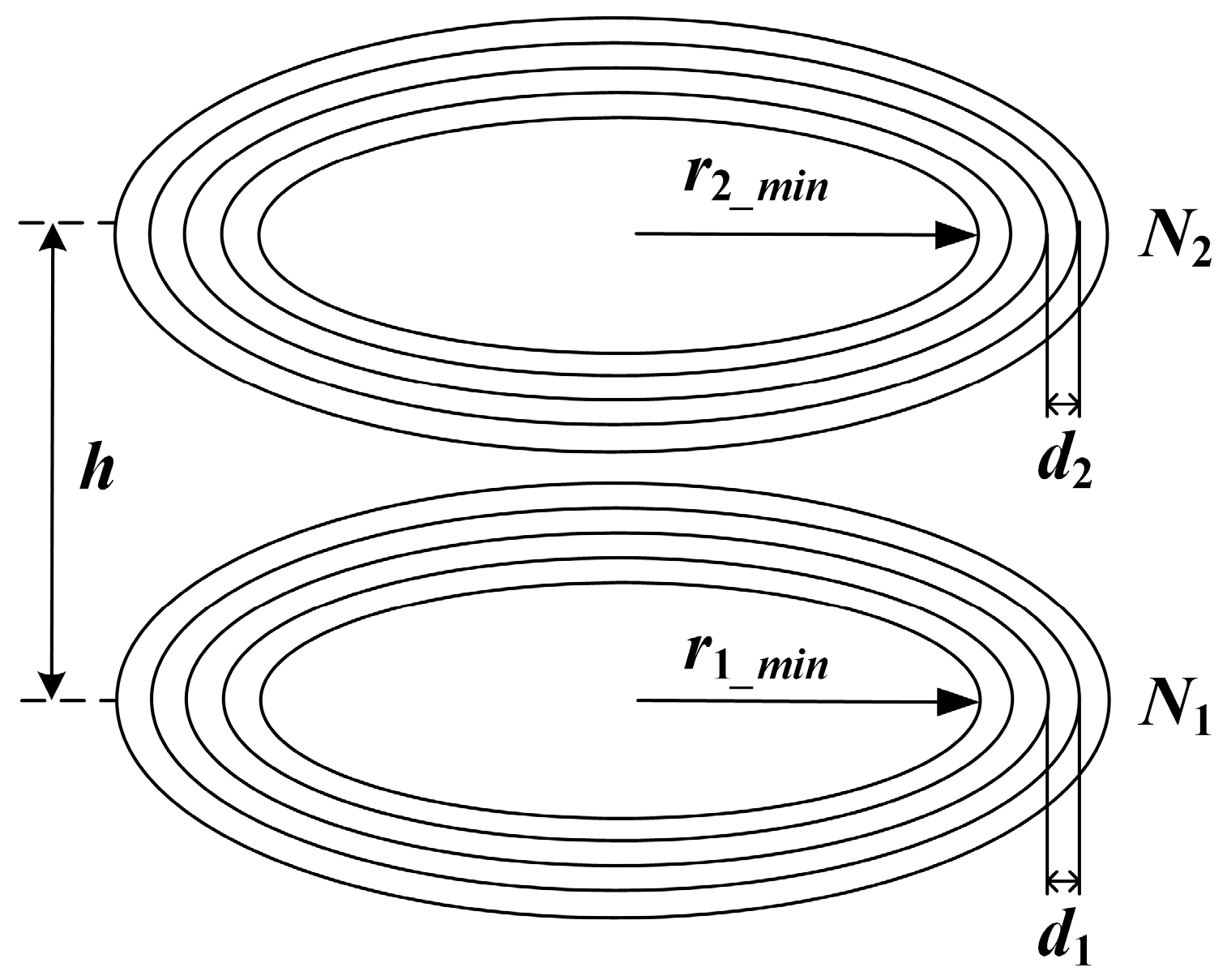
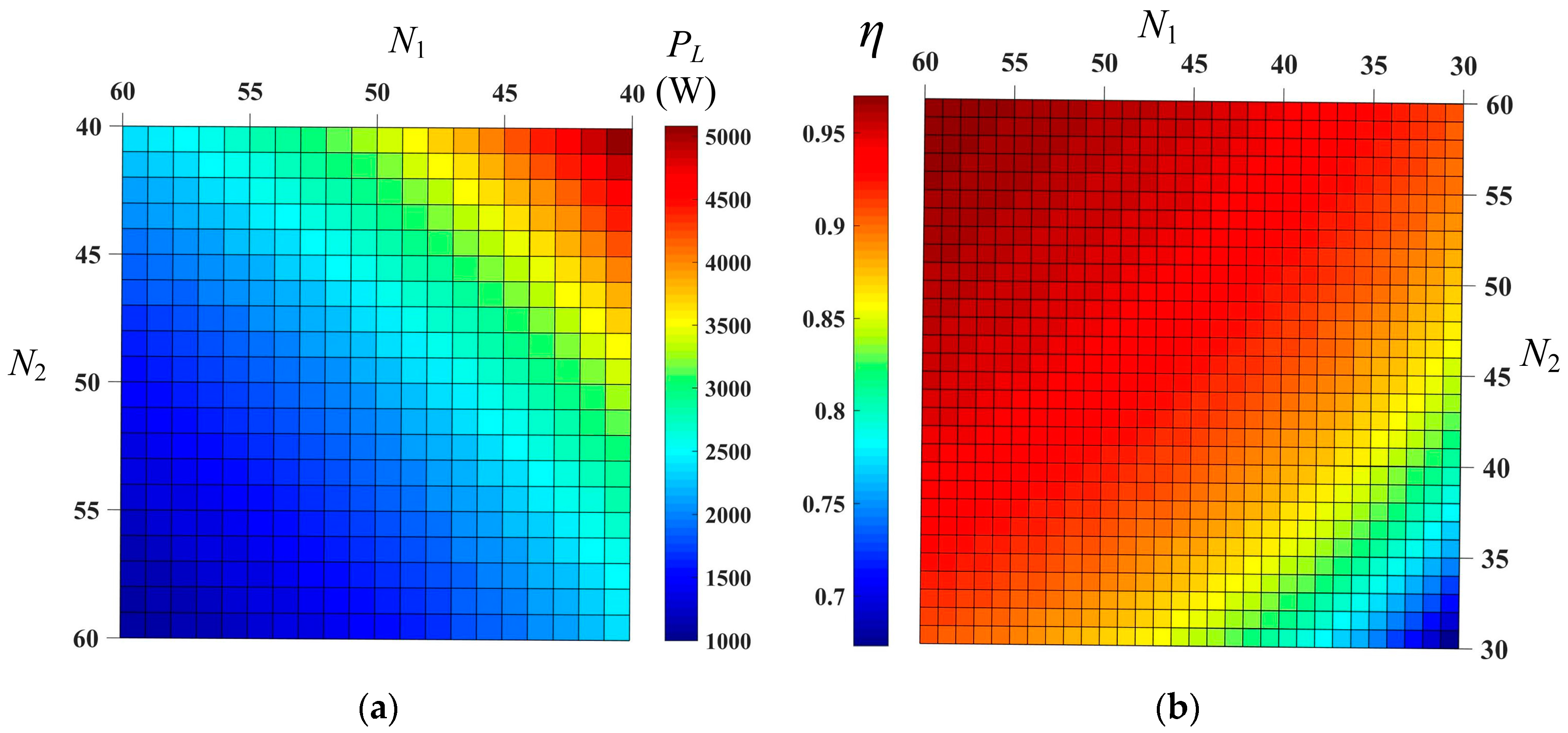
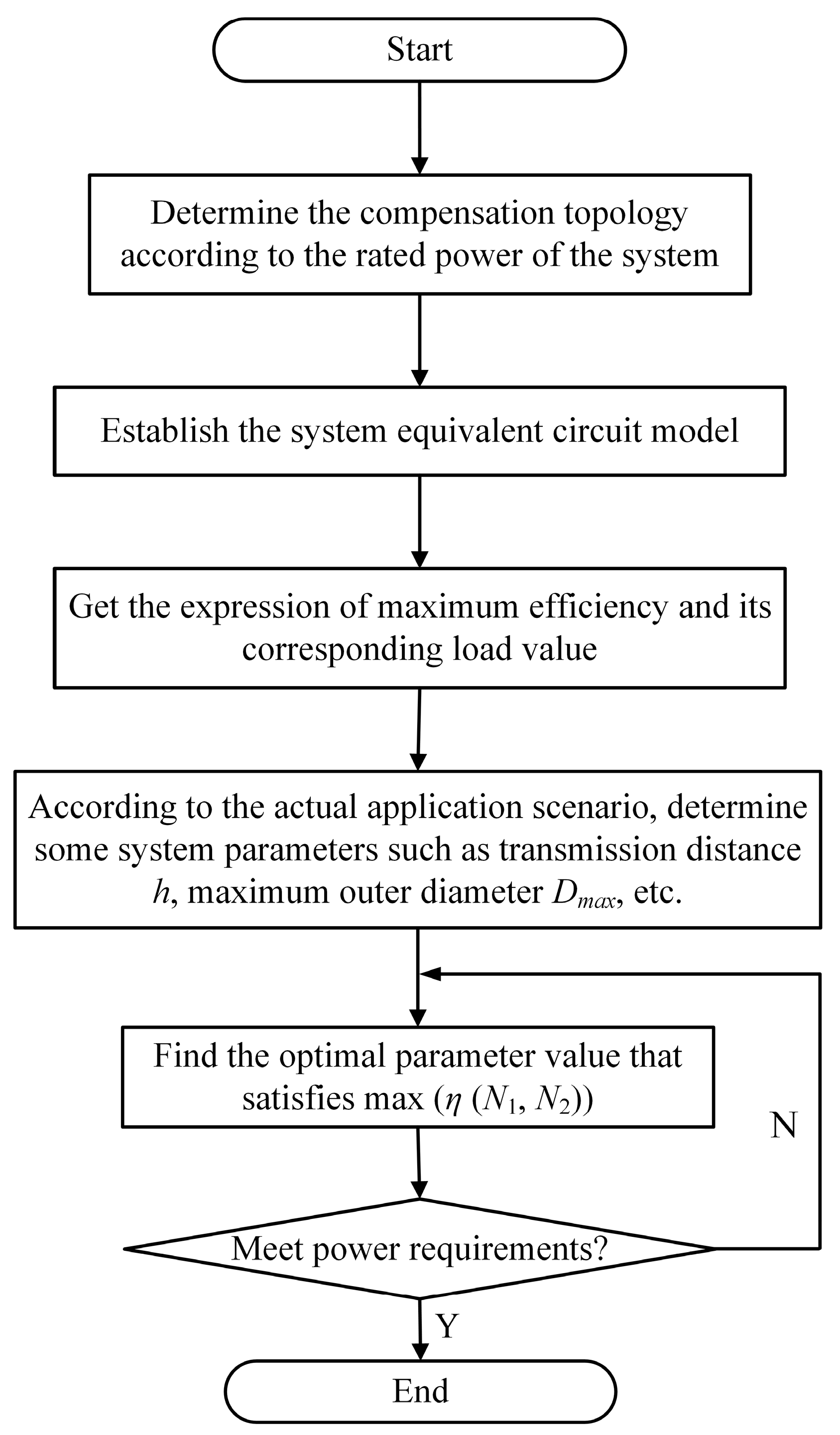
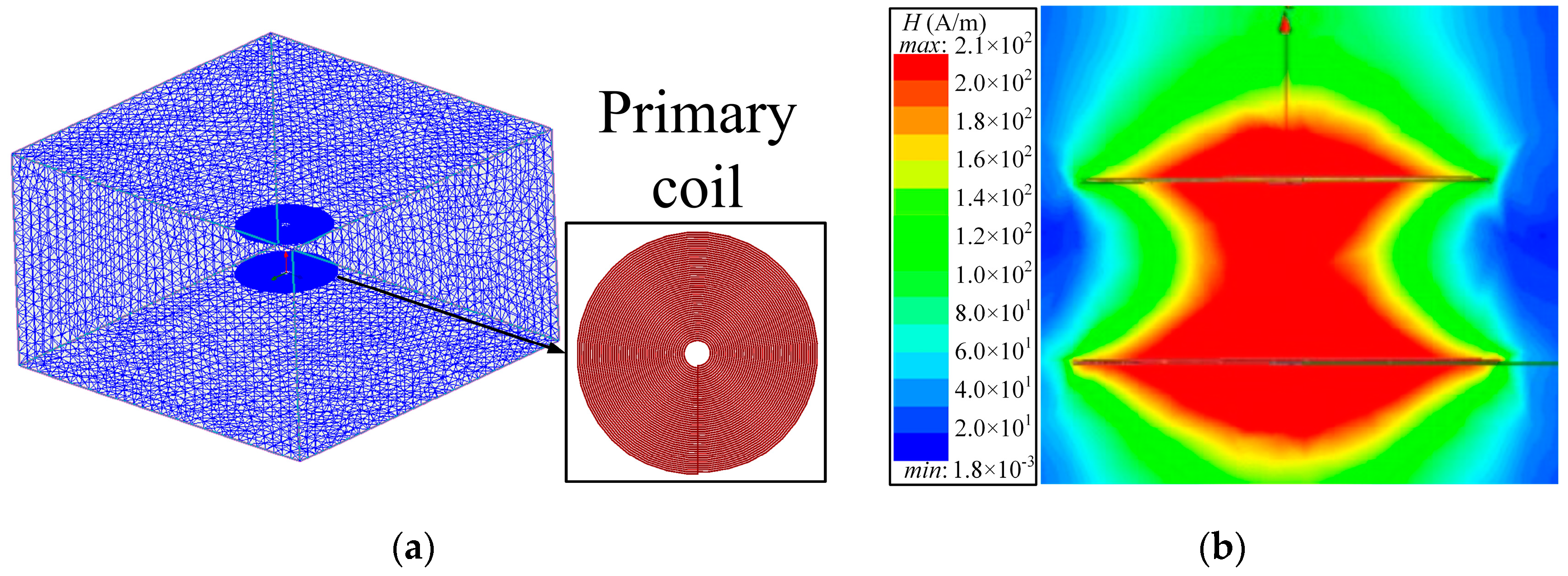
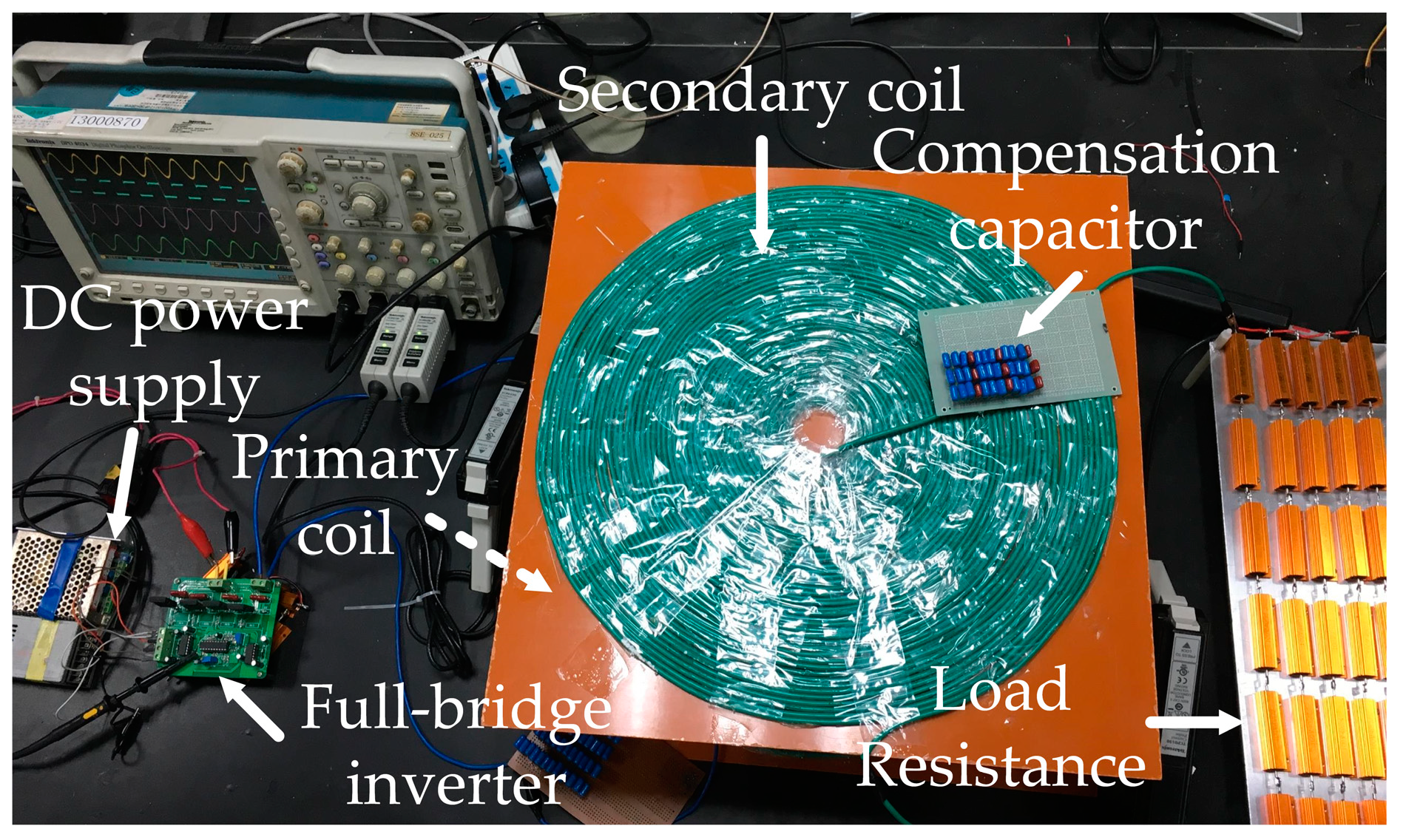
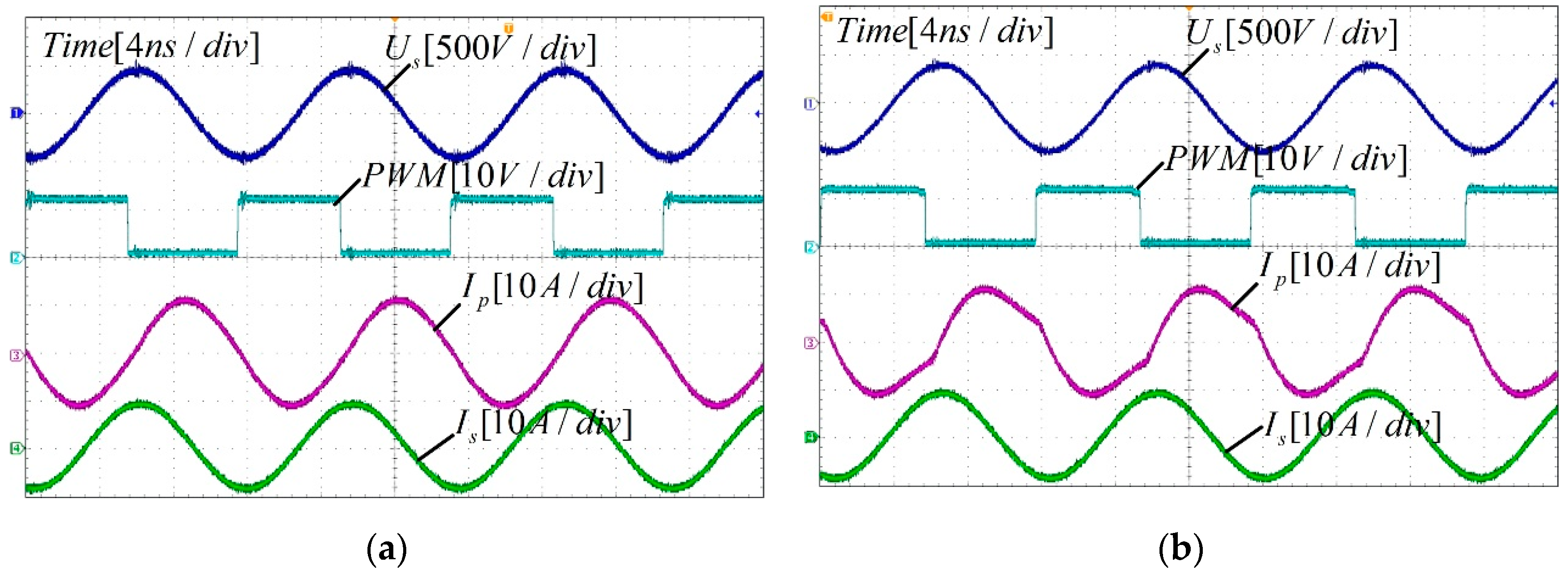
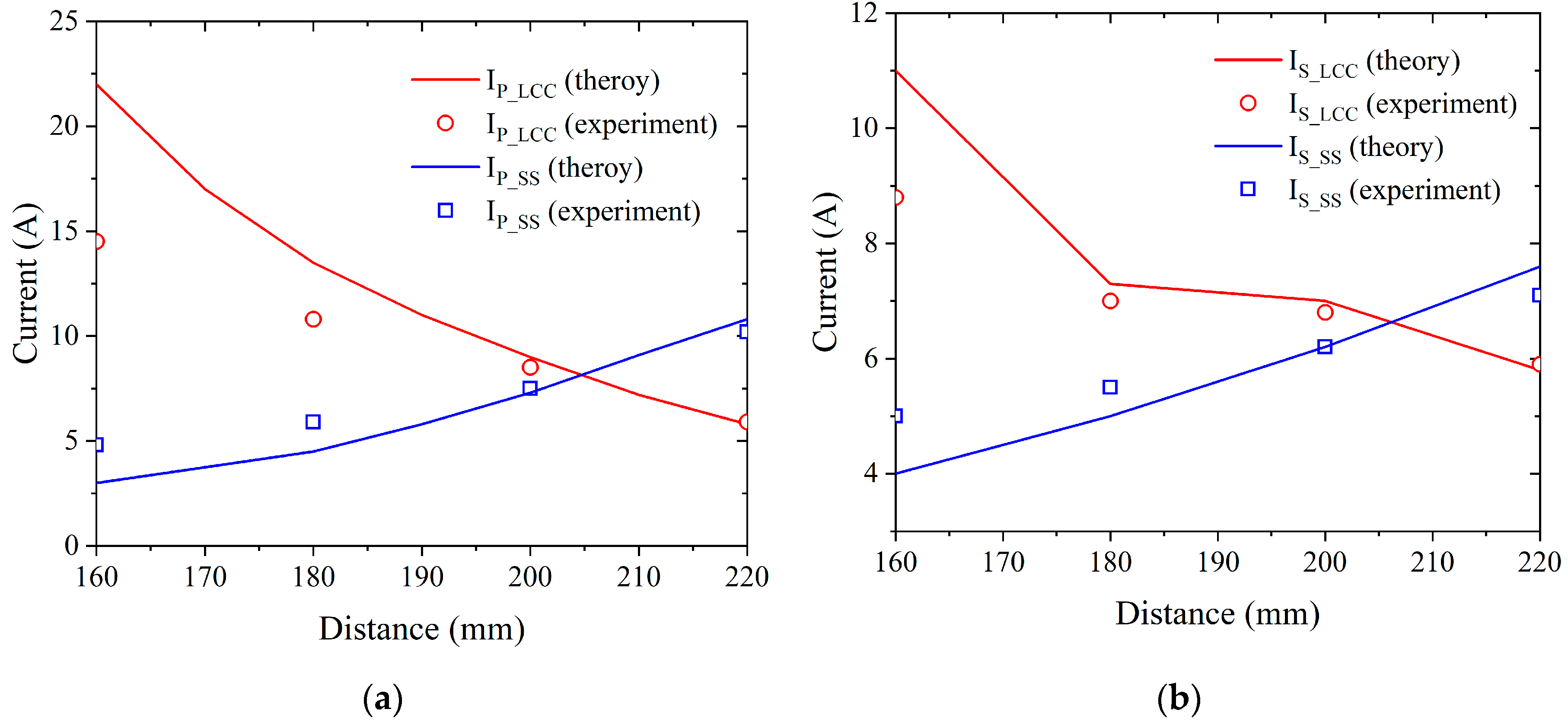
| Parameter | Value | Unit |
|---|---|---|
| resonance inductance L1 | 477.4 | μH |
| resonance inductance L2 | 426 | μH |
| primary coil turns N1 | 50 | - |
| secondary coil turns N2 | 48 | - |
| resonance capacitor C1 | 7.34 | nF |
| resonance capacitor C2 | 8.23 | nF |
| input voltage | 300 | V |
| output power | 2 | kW |
| Parameter | Value | Unit |
|---|---|---|
| resonance inductance Lf1 | 64.9 | μH |
| resonance inductance L f2 | 93.6 | μH |
| resonance capacitor C1 | 54.0 | nF |
| resonance capacitor C2 | 37.5 | nF |
| resonance capacitor Cp1 | 9.1 | nF |
| resonance capacitor Cp2 | 10.5 | nF |
| output power | 2.45 | kW |
| Parameter | Theoretical Value | Simulation Value | Measured Value |
|---|---|---|---|
| primary coil self-inductance (μH) | 477.4 | 481.5 | 475.2 |
| secondary coil self-inductance (μH) | 426.1 | 428.3 | 423.1 |
| mutual inductance (μH) | 82.0 | 82.6 | 81.2 |
| coupling coefficient | 0.18 | 0.18 | 0.18 |
| Parameter | SS Simulation | SS Experiment | LCC Simulation | LCC Experiment |
|---|---|---|---|---|
| input voltage | 300 V | 300 V | 300 V | 300 V |
| input current | 7.2 A | 7.56 A | 8.857 A | 8.52 A |
| input power | 2.161 kW | 2.268 kW | 2.657 kW | 2.556 kW |
| load voltage | 316 V | 319 V | 352.1 V | 339.6 V |
| output power | 1.994 kW | 2.011 kW | 2.475 kW | 2.282 kW |
| efficiency | 92.26% | 88.67% | 93.14% | 89.28% |
| Load | SS | LCC with Fixed Parameters | LCC with Adjusted Parameters | Adjusted Lf1 | Adjusted Lf2 | |||
|---|---|---|---|---|---|---|---|---|
| Power | Efficiency | Power | Efficiency | Power | Efficiency | |||
| 10 Ω | 455.2 W | 68.6% | 478.7 W | 73.7% | 3295.1 W | 89.0% | 1.4 μH | 18.7 μH |
| 33 Ω | 1331.8 W | 82.8% | 1559.5 W | 87.7% | 3323.5 W | 89.3% | 66.3 μH | 61.8 μH |
| 50 Ω | 2011.0 W | 88.7% | 2282.1 W | 89.3% | 3302.1 W | 89.8% | 54.3 μH | 93.6 μH |
| 83 Ω | 3170.0 W | 85.6% | 3210.7 W | 86.7% | 3313.0 W | 89.5% | 41.2 μH | 155.4 μH |
© 2020 by the authors. Licensee MDPI, Basel, Switzerland. This article is an open access article distributed under the terms and conditions of the Creative Commons Attribution (CC BY) license (http://creativecommons.org/licenses/by/4.0/).
Share and Cite
Wen, F.; Chu, X.; Li, Q.; Gu, W. Compensation Parameters Optimization of Wireless Power Transfer for Electric Vehicles. Electronics 2020, 9, 789. https://doi.org/10.3390/electronics9050789
Wen F, Chu X, Li Q, Gu W. Compensation Parameters Optimization of Wireless Power Transfer for Electric Vehicles. Electronics. 2020; 9(5):789. https://doi.org/10.3390/electronics9050789
Chicago/Turabian StyleWen, Feng, Xiaohu Chu, Qiang Li, and Wei Gu. 2020. "Compensation Parameters Optimization of Wireless Power Transfer for Electric Vehicles" Electronics 9, no. 5: 789. https://doi.org/10.3390/electronics9050789
APA StyleWen, F., Chu, X., Li, Q., & Gu, W. (2020). Compensation Parameters Optimization of Wireless Power Transfer for Electric Vehicles. Electronics, 9(5), 789. https://doi.org/10.3390/electronics9050789






